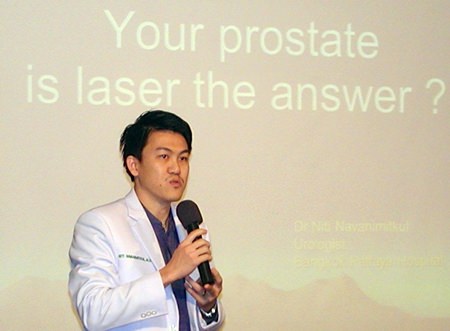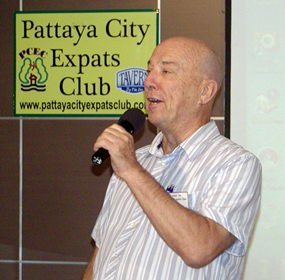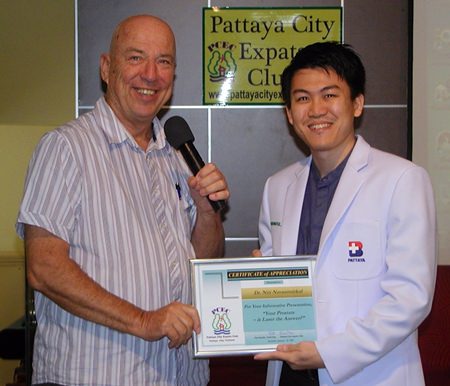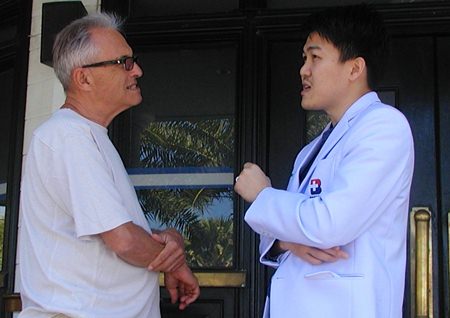This was the topic of Dr. Niti Navanimitkul, M.D., Urologist at Bangkok Hospital Pattaya, in his presentation to the Sunday, January 12 meeting of the Pattaya City Expats Club.
Dr. Niti received his medical education and degree from the Faculty of Medicine at Chiang Mai University from 1997 to 2003 and did his residency at the Department of Urology, Chiang Mai University from 2006 to 2010. His professional experience has been as a Urologist at Phranakorn Sri Ayutthaya Hospital from 2010 to 2012 and at Bangkok Hospital Pattaya since 2012.
 Dr. Niti Navanimitkul, M.D., Urologist, of Bangkok Hospital Pattaya, was the guest speaker for the Sunday, January 12 meeting of the Pattaya City Expats Club.
Dr. Niti Navanimitkul, M.D., Urologist, of Bangkok Hospital Pattaya, was the guest speaker for the Sunday, January 12 meeting of the Pattaya City Expats Club.
First, he displayed a diagram of the male reproductive tract and explained how the prostate gland functions in this process. He then said as men grow older, the prostate gland grows larger. The medical name for an enlarged prostate is Benign Prostatic Hyperplasia (BPH), also known as Benign Prostatic Hypertrophy. It is “benign” in the sense that it is not a cancerous condition, and so BPH should not be confused with prostate cancer.
 MC Roy Albiston opens the 12th of January PCEC meeting by welcoming all, and inviting new members & guests to introduce themselves.
MC Roy Albiston opens the 12th of January PCEC meeting by welcoming all, and inviting new members & guests to introduce themselves.
The symptoms of BPH include interruptions in the urinary stream, frequent urination (especially at night), an urgent need to urinate, a weak urinary stream, and problems starting urinating. Also, he explained that an enlarged prostate can lead to acute or chronic urinary retention, which can cause bladder infection, a stone in the bladder or damage to the kidney.
Further, to diagnose BPH and its severity, doctors will check your symptoms and may perform one or more of the following tests: digital rectal examination, a urine fluid test, a PSA blood test, a urine flow test or an ultrasound scan. Depending on its severity, there are three treatment options; lifestyle changes, medicines, or surgery.
Dr. Niti described the lifestyle changes which include (1) drinking less alcohol, caffeine, artificial sweeteners and carbonated beverages; (2) drinking less in the evening; (3) eating more fruit and fiber; (4) emptying your bladder; (5) double voiding (urinate, relax for five minutes, and repeat urination); (6) checking your medicine; and (7) bladder retraining.
There are three kinds of medicines used to treat BPH: (1) alpha-blockers; (2) 5-alpha reductase inhibitors; and (3) herbal treatment. Alpha-blockers include tamsulosin, alfuzosin, doxazosin and terazosin. These drugs relax smooth muscles, especially in the bladder neck and prostate. The 5-alpha reductase inhibitors include Proscar (generic name: finasteride) and Avodart (generic name: dutasteride). These block the conversion of testosterone to dihydrotestosterone, the male hormone that stimulates the prostate; they are better for men with significantly enlarged prostates. Some symptoms may be treated effectively with over-the-counter herbal remedies (saw palmetto, red clover, soy, African tree bark).
There are several surgical options for treating BPH. Surgery is usually done only for the most severe cases. One surgical option is an open prostatectomy. The surgery does not remove the entire prostate, as is done in a prostate cancer operation, but removes just the obstructive part of the prostate that blocks the flow of urine.
 MC Roy Albiston presents Dr Niti with a Certificate of Appreciation from PCEC as thanks for his presentation, which was of benefit to over half the audience.
MC Roy Albiston presents Dr Niti with a Certificate of Appreciation from PCEC as thanks for his presentation, which was of benefit to over half the audience.
Another is the transurethral resection of the prostate, commonly known as “TURP.” In this procedure a combined visual and surgical instrument is inserted through the tip of the penis and into the tube that carries urine from the bladder (urethra). The urethra is surrounded by the prostate. Using this resectoscope, the doctor trims away excess prostate tissue that’s blocking urine flow and increases the size of the channel that allows you to empty your bladder.
 Member Ed chats with Dr Niti following the meeting.
Member Ed chats with Dr Niti following the meeting.
Finally, patients can opt for an operation performed using laser (there are several kinds) – Thulium laser, PVP (green-light laser), and Diode laser. The advantages noted by Dr. Niti for laser surgery over the TURP are (1) fewer complications during the surgery; (2) less erectile dysfunction post-operation; (3) shorter time for catheter to be inserted; and (4) shorter hospital stay. Green-Light Laser Prostatectomy allows vaporization of tissue and simultaneously seals the tissue resulting in an almost bloodless field.




